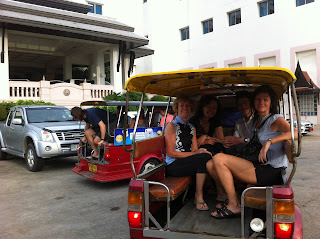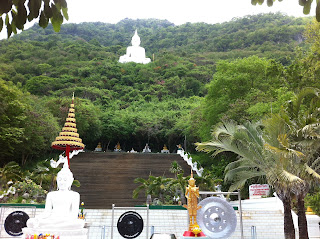Our latest adventure was a cycling trip to Thailand. A friend and I started out the trip on a Central Thailand outing with SpiceRoads, an Asian cycling tour company. We met up in Bangkok where our guide picked us up and we headed out to the floating markets. Here everything is sold on the water, even including food they have made on the boats. Although there seemed to be more tourists than locals, the sights and smells were unique. I sampled the coconut ice cream (my favorite) and here it came in a coconut shell with pieces of fresh coconut in the bottom. We boarded one of the long tail boats and cruised through the canals, along floating houses; kids bathing in the water and low hanging bridges. We got on our bikes and started riding through the countryside, lots of rice fields all around. The lunch stop was near a 200 year old temple that had been taken over by a Banyan Tree. Hoping back on the bikes we continued on our journey, discovering that part of the trail was actually a narrow sidewalk in front on the houses with the canal on the other side. Apart from a few scares with barking dogs, no one fell in. The hotel that evening was in Kanchanaburi and the pool was a welcoming sight.
 |
| Cycling path along the canal |
 |
| 200 year old temple |
 |
| Temple covered in Banyan Tree roots |
 |
| Bike path up and over the stairs |
 |
| Coconut ice cream in a shell |
 |
| Hotel pool |
 |
| Floating market |
 |
| Tourists at the floating market |
 |
| Cooking on the boats |
 |
| Houses along the canal |
 |
| Lots of flowers along the canal |
Day 2 was a visit to the war museum, cemetery and the “Bridge
over the River Kwai.” We actually took the train along the tracks built by the
POWs during WWII, beautiful scenery along the river with lots of flowers in
bloom. It was an open air train, but the breeze kept it cool. The wooden seats
did get hard after a while, but luckily the lunch stop arrived just in time. Lunch
was along the river and then back on the bikes riding onto our next stop. We
got into the hotel just before the lightning and thunder started, so much for
swimming. We listened to the pouring rain and finally braved our way through
the river that had formed in the parking lot to dinner.
 |
| Bridge over the River Kwai |
 |
| Floating restaurants on River Kwai |
 |
| Hotel on the River Kwai |
 |
| Hanging out of the train taking photos |
 |
| Temple in Khmer architecture style from Cambodia |
The next morning’s ride started from the hotel and continued
into the country side. We rode along dirt roads that were primarily rice
fields, taro plants, banana trees and rubber plants. It was so peaceful to not
have to worry about cars anywhere. We came upon two large Buddhas, hard to
believe enough people would be in this area to see them. At the end of the ride
the van picked us up and drove us to Ayutthaya, the early capital of Thailand
where we spent the night. Dinner was at a great place on the river, hard to
believe that only a few months earlier the river had been up over the roof of
all the places along there.
Yes, it is true; two hours north of Bangkok is a wine
country. They grow mostly Chenin Blanc and Syrah grapes, so it is warm, but
drier than most of Thailand. The houses and terrain reminded me more of Napa
than Thailand. Many wealthy people have second homes in the area, which are
large and modern. The wine was actually very good, but not a bargain price wise
as most of Thailand is. The winemakers are trained in Germany and New Zealand
and they had all the latest equipment including wine barrels from France. It is
similar to Napa in that the owners have made their money in other areas and
then start a winery. We spent the weekend cycling through the area, tasting
wine and touring temples. As with every trip we have to have a point at which
Bob is sure I am trying to do him in. This trip was no exception as we climbed
the 650 stairs up to the large Buddha. Once we got there he did agree the view
was worth it, but in the heat it is slow process. All in all a great trip!



























































